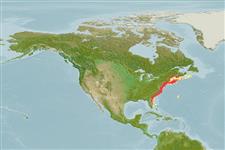Environment: milieu / climate zone / depth range / distribution range
Ecologia
marinhas; estuarina demersal; oceanódromo; intervalo de profundidade 10 - 183 m (Ref. 5951), usually ? - 37 m (Ref. 5951). Temperate; 45°N - 25°N, 81°W - 57°W
Northwest Atlantic: Maine (rarely Nova Scotia, Canada) to southern Florida, USA.
Comprimento de primeira maturação / Tamanho / Peso / Idade
Maturity: Lm 28.0 range ? - ? cm
Max length : 94.0 cm TL macho/indeterminado; (Ref. 7251); peso máx. publicado: 12.0 kg (Ref. 7251); idade máx. registrada: 9 anos (Ref. 52684)
Adults usually prefer hard sandy substrate where they can burrow; can exploit a broad range of lower and mid-estuary habitats including salt marsh creeks and seagrass beds, which usually have muddy or silty substrates , as well as sand flats (Ref. 26621). Occur in bays, lagoons and shallow coastal waters. Utilized fresh and frozen; can be steamed, fried, boiled, microwaved and baked (Ref. 9988). Exported fresh to Japan for sashimi.
Distinct pairing (Ref. 205).
Robins, C.R. and G.C. Ray, 1986. A field guide to Atlantic coast fishes of North America. Houghton Mifflin Company, Boston, U.S.A. 354 p. (Ref. 7251)
Status na Lista Vermelha da UICN (Ref. 130435)
Ameaça para os humanos
Other
Uso pelos humanos
Pescarias: espécies comerciais; peixe esportivo: sim
Ferramentas
Relatórios especiais
Baixar XML
Fontes da internet
Estimates based on models
Preferred temperature (Ref.
123201): 9.1 - 24.4, mean 19.1 °C (based on 12 cells).
Índice de diversidade filogenética (Ref.
82804): PD
50 = 0.5000 [Uniqueness, from 0.5 = low to 2.0 = high].
Bayesian length-weight: a=0.00589 (0.00468 - 0.00742), b=3.17 (3.12 - 3.22), in cm total length, based on LWR estimates for this species (Ref.
93245).
Nível Trófico (Ref.
69278): 4.5 ±0.3 se; based on diet studies.
Generation time: 5.1 ( na - na) years. Estimated as median ln(3)/K based on 1
growth studies.
Resiliência (Ref.
120179): médio(a), tempo mínimo de duplicação da população 1,4 - 4,4 anos (K=0.77-0.84(?); assuming tm>=2; tmax=9).
Prior r = 0.86, 95% CL = 0.57 - 1.30, Based on 1 full stock assessment.
Fishing Vulnerability (Ref.
59153): Moderate to high vulnerability (47 of 100).
Climate Vulnerability (Ref.
125649): Moderate to high vulnerability (51 of 100).
Nutrients (Ref.
124155): Calcium = 25.9 [11.3, 42.8] mg/100g; Iron = 0.292 [0.145, 0.532] mg/100g; Protein = 16.5 [14.1, 19.7] %; Omega3 = 0.374 [0.200, 0.700] g/100g; Selenium = 16.3 [8.0, 35.8] μg/100g; VitaminA = 9.6 [2.5, 41.5] μg/100g; Zinc = 0.321 [0.219, 0.478] mg/100g (wet weight);
